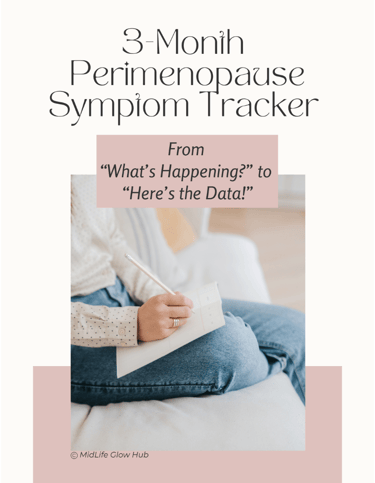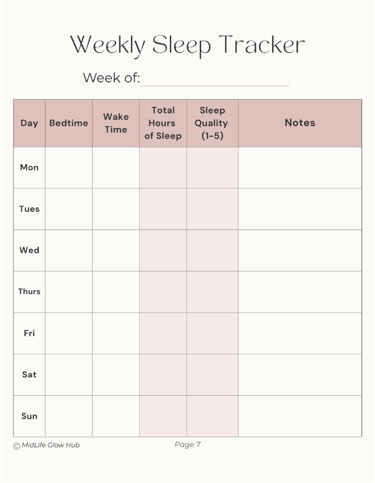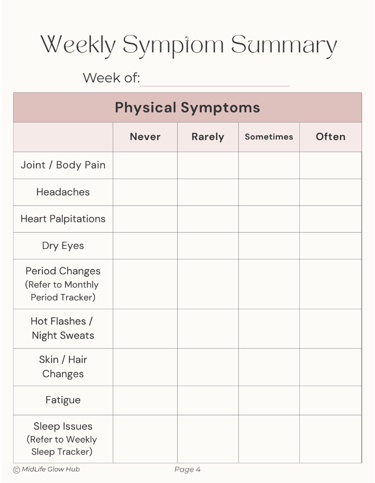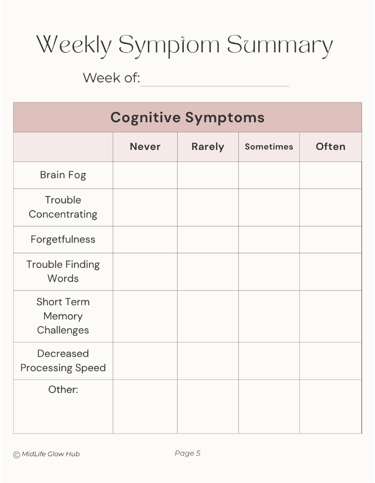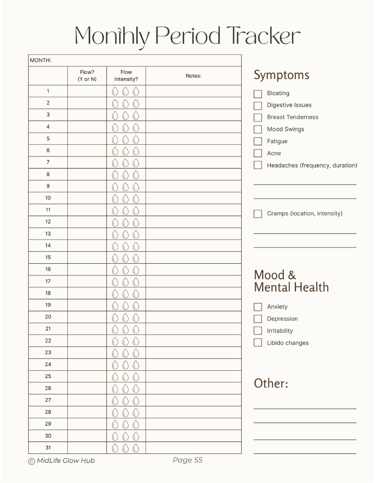Add your promotional text...
Is This Perimenopause or Just a Personality Shift? (Track It and Find Out!)
Feeling "off", emotional, or like your body’s staging a slow rebellion? Welcome to perimenopause. This blog breaks down the most common symptoms, and why tracking them matters. A lot.
6/5/20256 min read


This transitional phase can last anywhere from 2 to 10 years, because apparently the universe thinks we need bonus rounds in suffering. And during that time, your ovaries are slowly clocking out while your body tries to make sense of the chaos.
Here are just a few fan favorites from the Perimenopause Greatest Hits album:
Hot flashes (Because who doesn’t love spontaneously combusting in a meeting?)
Night sweats (Welcome to your new hobby: sweating through sheets.)
Irregular periods (Surprise! Or not. Who knows anymore?)
Mood swings (One minute you’re fine, the next you’re sobbing at a Swiffer commercial.)
Sleep issues (Insomnia brought to you by 3 a.m. anxiety and an overactive bladder.)
Brain fog (The word you’re looking for is...something...wait, what were we talking about?)
Weight gain or redistribution (Shout-out to the muffin top we didn’t order.)
Fatigue (A special kind of tired that sleep won’t fix.)
And just when you think you've identified all the usual suspects, perimenopause pulls a few more tricks out of its aging hormonal handbag. Ever had your shoulder suddenly decide it no longer wants to rotate? That’s frozen shoulder. And yes, it can be hormone-related. Or how about heart palpitations that make you wonder if you’re having a midlife existential crisis and a cardiac event at the same time? There’s also the slow vanishing act of your libido, the mysterious arrival of ear ringing (tinnitus), itchy ears (why?), and a sudden spike in body odor that makes you question your deodorant and your life choices. These aren’t just random annoyances. They’re part of the lesser-known, but totally legitimate, perimenopause playlist.
Some of these symptoms are well-known, others are weirdly specific. But all of them are real. What’s not so common? Actually talking about them. Or tracking them. Or realizing you don’t just have to grit your teeth, Google in secret, and “ride it out".
Perimenopause is real, it’s wild, and it deserves to be taken seriously. The more we normalize talking about it, and tracking it, the easier it becomes to advocate for ourselves in medical spaces.
So let’s stop pretending this is all just aging gracefully and start getting strategic.
Because glowing through midlife? It starts with figuring out what the hell is going on in your body.
You've got this, itchy ears and all. 💛
Hot Tip: If you’re looking to dive deeper into all things perimenopause and beyond, I highly recommend checking out The Pause Life website by Dr. Mary Claire Haver. She’s a board-certified OBGYN who breaks everything down in a clear, science-backed, no-nonsense way. There is a free Menopause Empowerment Guide available on the website which is a great starting point, especially if you want to feel more informed (and less overwhelmed) heading into your next appointment.
Hormonal? Absolutely!
Hopeless? Not Even Close!
Finally: A Way to Track the Chaos!
Ah, perimenopause. That delightful hormonal limbo where you’re somehow both sweating and freezing, wide awake at 3 a.m., and crying because someone looked at you weird. Or maybe it was the wrong kind of hummus. Hard to say.
If you’ve found your way here to the MidLife Glow Hub, chances are you’re deep in the “Is it just me?” phase of perimenopause. Spoiler alert: it’s not just you! You’re not broken. You’re just hormonally haunted.
Let’s talk about it.
The "Greatest Hits" of Perimenopause Symptoms
Track It or Wing It: One of These Gets You Better Care!
Let’s face it: going to the doctor and trying to explain the ever-changing horror show that is perimenopause from memory? Not going to happen. You’ll walk in planning to talk about your sleep issues and leave having discussed...a bruise on your toe. Somehow.
That’s why symptom tracking matters. Not in a "Dear Diary, I feel bloated again" kind of way. But in a DATA IS POWER kind of way. Because then you can say:
“I’ve had 11 hot flashes in the past 3 days.”
“My periods have been missing in action for 3 months, came back last week, and now I’m bleeding like I’m 17 again."
“I’m waking up at 2:47 a.m. every night and can’t fall back asleep for at least 2 hours.”
The specifics, such as duration and frequency of various symptoms, give your doctor something concrete to work with. This isn’t vague, “I don't feel like myself” territory. This is hard evidence.
And that means appropriate interventions can actually be considered. Like Hormone Replacement Therapy (HRT). Or lifestyle adjustments. Or testing for other issues that might be masking themselves as perimenopause.








I originally made a rough version of a perimenopause symptom tracker for myself, because trying to recall symptom specifics at the doctor’s office is like being asked to recite your grocery list from three Tuesdays ago. All while under fluorescent lights and wearing a paper gown. Questions like “How many nights have you had interrupted sleep?” or “When did the brain fog start?” sound totally reasonable… until you remember that you’re currently experiencing brain fog, which makes it nearly impossible to answer questions about brain fog. It’s not that the symptoms aren’t real—it’s that your brain is buffering like a slow Wi-Fi signal.
I’ve now fine-tuned it, not into a medical-grade masterpiece or anything, but it’s functional, honest, and actually helped me connect the dots. It gave me something concrete to bring to my doctor, instead of just wildly gesturing and saying, “Things feel… weird.”
The printable tracker is designed to help you spot patterns over time, prep for doctor appointments, and feel more in control of your midlife experience. Whether you're in the thick of perimenopause, feeling the shift into menopause, or navigating the aftershocks, this tracker has you covered.
In one easy PDF download, you’ll get a 94-page document that includes:
A “How This Is Organized” page with helpful tips to get you started
3 months of weekly symptom tracking in an easy, checklist-style format
Weekly sleep logs to help track rest (or the lack of it)
Monthly period trackers to spot cycle changes over time
Weekly reflection pages to catch trends in physical, emotional, and hormonal shifts
A bonus daily tracker page, for when symptoms need more detailed tracking (print as needed)
A 2-page appointment prep section so you can walk in informed—not frazzled
This tracker is designed to be flexible, so you don’t have to use every section right away. If you only want to focus on sleep and your cycle for now, that’s totally fine. Use the pages that fit your needs, skip what doesn’t, and come back to other sections if (or when) things shift. This is your midlife, your data, your way.
Use it daily, weekly, or whenever you remember where you put it. Track the physical, the emotional, and the hormonal. No symptom is too small! Then take it with you to your next doctor’s appointment like the prepared adult woman you absolutely still are (despite what your anxiety and chin hair say).
Note: This tracker is not a fillable PDF. It's meant to be printed so you can circle, underline, doodle, and make it yours.
👉 Grab the Perimenopause Symptom Tracker PDF by clicking here and take one small step toward less chaos and more clarity.
